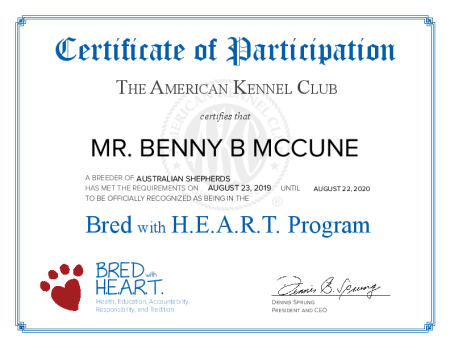

HONEYCREEKAUSSIES.COM
Australian Shepherds - The Breed that Works.
Honeycreek Australian Shepherds
We Love Our Friends
Aussie's - Loyal, Playful, Loving
The Family Welcomes You To Our World

Breeding Australian Shepherds
What you should know and ask your breeder.
About Our Dogs and their puppies.
I am going to try and explain the Australian gene/colors/types as best I can but I am not going to go into the how to breed side of things just going to inform you on our dogs so you know as much as possible prior to making a decision about a puppy.
There is more to it than I am going to say here but just trying to make it understandable for all. So anyone reading this that IS a breeder understand all I am doing is simplifying things I fully understand there is more to it than I am writing it for a prospective pet owner just does not need to go that far into details. If your a breeder looking for a new puppy then you already know and no need for me to go further.
Ok here is the short version as follows.
There are 4 colors the Australian Shepherd can be, blue merle, black (or Tri-Black), red merle and red. (All 4 colors) Each of these can have a copper or white trim. The basic colors are body colors of black and red. The merle gene is added to create the distinct colors of the Aussies.
You cannot (key word here) SAFELY breed a Merle to Merle and get quality puppies the gene in them just will not allow it. This produces a Double Merle and the homozygous merle as a result of this cross will have various degrees of problems including possible deafness and blindness ranging from slight to severe cases.
This condition can occur in 25 percent of the litter babies a normal litter being 7 baby pups. So roughly 2-3 pups could be affected by this condition IF Merle to Merle breeding is done.
Breeding of Tri-Blacks or Tri-Reds is fine just please unless you know what you are doing do not breed any Merle to another Merle I promise you it will not be a good thing for you or the puppies as you will have to put some new borns down and that is never good.
Our Dogs
Our male, Rusty is a Tri-Black (not a merle).
Daisy one of our females is a Blue Merle
Brandy our other female is a Red Merle
Molly our other female is a Tri-Red (not a merle)
Penny another of our Females is a Tri-Black
These are our dogs so we will not have any merle to merle breeding, none, 0, not going to happen here.
With this match up it will be like this:
So no matter which female has the puppies Rusty (aka: AKC name Prince Rusty) is the sire and he is Tri-Black so the dreaded merle defect does not come into play.
About Australian Shepherds and Colors.
Now as said there is 4 colors of Australian Shepherds, that is 4 colors recognized by the AKC there are more just not recognized by breed standards.
Let it be known here though AKC only recognizes the true 4 main colors there is nothing wrong with these dogs they just have a predominant gene that in laymen terms overpowers the normal accepted genes of a Aussie. They still will make very fine pets you just will not be able to show them in any AKC sanctioned function.
Dilute Blue (Maltese) Merle Dogs
Dilute blue merles can be hard to tell from regular blue merles. The difference is that they do not have any true black. Their non-merled areas will be gray, rather than black. Their noses, lips, eye rims, and paw pads will be slate colored. It can be hard to see this in photographs. This color is sometimes referred to as "Maltese."
Dilute Red (Isabella) Merle Dogs
Dilute red merles can be hard to tell from regular red merles. Part of the problem is that even in non-dilute reds, there is a wide range of red coloring, everything from very dark liver/chocolate colors down to so-called "pink" or orange shades. Regular red merles should always have darkly pigmented noses, lips, eye rims, and paw pads. A dilute red merle should have a lighter shade, with a bit of a silvery cast (Weimaraners are actually dilute reds). This color is sometimes referred to as "Isabella" or "fawn" (some breeds use fawn when referring to sable dogs, so double check!)
Yellow, Sable and Sable Merle Dogs
Though not common there is also Yellow, Sable and Sable Merle colors that can appear in Australian Shepherds.
Sable is markedly similar to yellow, in that it changes the color of the hair from black (or red) to yellow. In sable dogs, a percentage of the hairs will have black (or red) tips. Sometimes it's just a "dusting" of black tips, but other times the dog can look almost solid black. The black is typically concentrated on the dog's face, shoulders, and along the spine. Depending on the breed, sable is known by different names. Danes and Boxers call it fawn. Red Australian Cattle Dogs and Basenjis are actually sables. Sable in German Shepherds is a different gene altogether (part of the agouti series). Sables should always have black on their noses, lips, eye rims, and paw pads (unless the dog is a red sable, in which case these areas will be liver/brown). Differentiating between a sable with minimal dark pigment and a yellow dog can be difficult. One hint involves the dog's whiskers (vibrissae). If they are located in a pigmented area, sable dogs should have black whiskers.
Sable is a dominant gene, so a dog only needs one copy of the gene to be a sable. In order for a dog to have copper trim (black or red with tan on face and lower legs), it must have two copies of the genes for this pattern and so cannot carry a sable gene (and cannot produce sable pups unless bred to a sable dog). Because copper trim is popular, sable is very uncommon in Aussies. Sable merle is easier to detect than yellow merle, but still can be tricky. Since merle only visibly affects the fully pigmented hair tips, if the dog has minimal dark hair tips (and those are all or mostly merled), it could easily appear to be a solid colored dog. It is much easier to spot the merle in a newborn puppy's coat than in an adult dog. A clue is marbled (or solid blue) eye coloring, particularly in a dog with very little white.
As an aside, "gray" sables are the result of the chinchilla "C" series (which is an "albino" gene). This series only acts on "yellow" pigments (phenylalanine), turning them to gray. It won't affect a dog with only eumelanin (black and red) present in the coat. So a sable dog who is also carrying 2 copies of the chinchilla gene will have a gray base to the coat, rather than yellow (sometimes this is seen in Belgian Tervurens).
About Our Dogs and their puppies.
All of our dogs, Rusty, Daisy, Molly and Brandy are AKC registered as will their puppies have the ability for you to fully register them without us like some holding breeding rights away from you. The puppy will be yours without any holding rights by us 100 percent yours.
We have a 3 generation tree on our dogs and there is 0, none, not there family marker between any of them.
Nothing is perfect in life but we have tried to make it that way on our Aussies as best we could and we hopefully make it that way for your new friend as well.
If you have any questions or concerns by all means feel free to contact us, we or rather I will do what I can to answer your concern or question if I humanly can.


